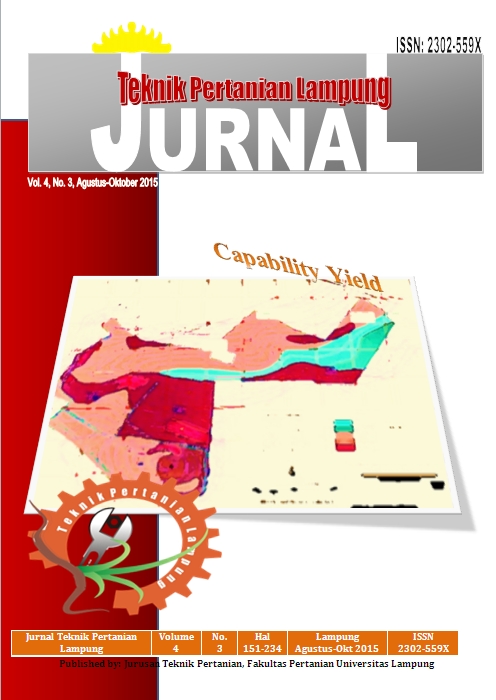CLASSIFICATION OF CAPABILITY YIELD ON LAPANG TERPADU LABORATORY AGRICULTURE FAKULTY, UNIVERSITY OF LAMPUNG
Abstract
Determination of land capabilityof Lapang Terpadu Laboratory FP Unila is very relevant. This researchaims todetermining land capability class on each unit of land in the Lapang Terpadu Laboratory FP Unila. The research
was conducted from June to October 2013, in the Lapang Terpadu Laboratory FP Unila of approximately 6.784
ha area. Thematerials used are a set of secondary datawhich includes climate data, thematicmaps, and chemicals
used for soil analysis in the laboratory. The tools used in this study include: Geographycal Position System(GPS),
abney level, ruler, compass, drill ground, ring samples, plastic bags, cameras, laboratory equipment, and stationery
(ATK). The studywas conducted by surveymethod. Data physical and chemical properties of the soil obtained by
observation in the field and soil sampling, and then analyzed in the laboratory. Furthermore, the determination
of land capability class is based on inhibiting factors developed by Klingebiel andMontgomery in 1973. Lapang
Terpadu Laboratory FP Unila has class III, IV, V, and VI, with themain limiting factor for the entire class of land
capability is the steepness of the slopes, except land units 2 is the permeability of the soil rather quickly, and land
units 1 is the threat of flooding. Lapang Terpadu Laboratory FP Unila dominated by land capability class IIIwith
land capability class III sub-P4 and III-C,e2, P4 is anarea of 3.989 haor 53.97%, then successivelyfollowed by the
class and sub-class IV land capability -D area of 1,708 ha, or 29.98%, the V-04 area of 0.737 ha or 10.87%, and
the last class VI-E covering an area of 0.351 ha, or 5.17%.
Keywords: class slopes, land capability class, inhibiting factors.
Downloads
Published
2015-10-30
Issue
Section
Articles
License
- Authors who publish with this journal agree to the following terms:
- Authors retain copyright and grant the journal right of first publication with the work simultaneously licensed under a Creative Commons Attribution-ShareAlike 4.0 International Lice that allows others to share the work with an acknowledgement of the work's authorship and initial publication in this journal.
- Authors are able to enter into separate, additional contractual arrangements for the non-exclusive distribution of the journal's published version of the work (e.g., post it to an institutional repository or publish it in a book), with an acknowledgement of its initial publication in this journal.
- Authors are permitted and encouraged to post their work online (e.g., in institutional repositories or on their website) prior to and during the submission process, as it can lead to productive exchanges, as well as earlier and greater citation of published work (See The Effect of Open Access).
Jurnal Teknik Pertanian Lampung

JTEPL is licensed under a Creative Commons Attribution-ShareAlike 4.0 International License.

